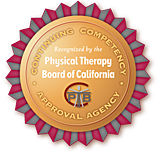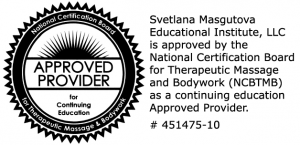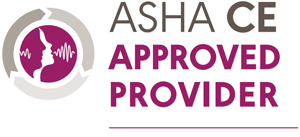


Event Registration


endorsement of specific course content, products, or
clinical procedures by AOTA or indicate AOTA approval
of a certification or other professional recognition.
This course is offered for 3.2 AOTA CEUs /
32 Contact Hours (Introductory level;
Occupational Therapy Process: Evaluation, Intervention)


Educational Institute LLC
3.2 ASHA CEUs
does not imply endorsement of course content, specific
products or clinical procedures.
MNRI® Children with Challenges Reflex Integration
A hard copy of the manual will be provided.
Dates: November 15-18, 2019
Location: Orlando, FL
Address: MNRI Training Facility, 6275 Hazeltine National Drive, Orlando, Florida
Instructor: Pamela Curlee
CEUs: This course is offered for 3.2 ASHA CEUs
(Introductory level, Professional area)
This course is offered for 3.2 AOTA CEUs / 32 Contact Hours
(Introductory; Occupational Therapy Process: Evaluation, Intervention)
CE Hours: This course is offered for 32 NCBTMB CE Hours
- MNRI® Dynamic and Postural Reflex Integration
- MNRI® NeuroTactile Integration
The Masgutova Method® is a set of programs focused on the restoration and maturation of primary movements, reflexes, coordination systems, skills for optimal performance of natural mechanisms, developmental processes, brain functioning, and sensory-motor integration. You can read more about Reflexes and MNRI HERE.
Watch an overview of how MNRI works
The Mission of the Svetlana Masgutova Educational Institute (SMEI) is to provide health, wellness and educational professionals, parents, and caregivers with non-invasive techniques to address maturational, developmental, and life challenges.
Course Overview
The Children with Challenges Reflex Integration course focuses on individualizing programs for children who have highly significant developmental challenges. These individuals may display aggressive behavior, deep worry and fear, have autism, cerebral palsy, or delayed intellect or emotional development. These children have great needs and are often the most challenging to assess, understand, and support. This four-day course trains professionals, parents and caregivers how to adapt MNRI techniques despite the depth of challenge present. General MRNI Method theory is also emphasized during this class as the material covers a broad range of developmental deficiencies and associated reflex patterns.
Learning Objectives: MNRI® Children with Challenges Reflex Integration
- Describe the Masgutova Neurosensorimotor Reflex Integration (MRNI®) Method and movement as the basis of natural development.
- Describe the role of a reflex and its sensory, motor and central nervous system mechanisms.
- Describe primary motor reflex patterns, the subordinate role each plays in the maturation of more complex related motor reflex schemes (sitting-up, crawling, etc), the development of learned motor, communication and cognitive abilities and in achieving potential across an individual’s lifespan.
- Describe the effects of a non-integrated reflex on the brain-body system as well as the effects on receptive and expressive language skills.
- Define reflex and explain its level/s of development relative to the brain neurological maturation.
- Describe the impact of:
- Trauma on primary motor reflex patterns, the protective role immature reflexes play, and the negative impact protection can have on an individual’s ability to self-regulate, learn, develop and grow.
- Stress and negative learning experiences on the integration of reflexes necessary for reading, writing, eating, core stabilization, visual/motor integration, speech/language development and auditory processing.
- Explain the use of these strategies to release non-productive protection tendencies which keep people from reaching their goals, potential, and from making productive decisions.
- Describe the physiological and psychological basis of movement, the sensory-motor concept of reflex integration, the development of a reflex from appearance to integration, and the characteristic components of reflexes for children and adults with developmental challenges.
- Explain why hypertonic muscles inhibit the development of a child/adult.
- Demonstrate different adaptive techniques for working with hyper and hypo active muscle tone throughout the body.
- Explain and review knowledge from the MRNI® Dynamic and postural Reflexes classifications as they relate to children and adults with challenges.
- Explain the natural ability for positive change and its effect on the body structure, postures, movements of the body, and various coordination systems.
- Analyze various reflexes patterns, their sensory stimuli and motor responses, stages of each reflex’s development, and how this effects the upper limbs, lower limbs, and whole core.
- Explain the importance of developing individualized programs for clients having emotional, motivational, speech and language, and movement challenges.
- Describe how the activation of reflex patterns facilitate neurodevelopmental mechanisms for proper physiological functions which provide for easier learning for sensory-motor abilities and skills necessary for daily life functions.
- Explain how the integration of the primary motor patterns support cognitive development.
- Explain the purpose of automaticity of reflexes pre and post birth and how to use this automaticity to facilitate development in individuals with deficits in neurodevelopment.
- Analyze and describe the Body Right-Left Motor Coordination Reflex Patterns for Robinson Hand Grasp, Hands Pulling, Leg Cross Flexion-Extention, Babinski, Babkin Palmomental, Asymmetrical Tonic Neck, and Bonding Reflexes.
- Demonstrate the effective integrative exercises for Body Right-Left Motor Coordination Reflex Patterns for Robinson Hand Grasp, Hands Pulling, Leg Cross Flexion-Extention, Babinski, Babkin Palmomental, Asymmetrical Tonic Neck, and Bonding Reflexes and its effect on auditory processing, communication and expressive language.
- Analyze and describe the Body Upper-Lower Motor Coordination System for Automatic Gait, Motor Embrace, Bauer Crawling, Hands Supporting, Landau, Flying and Landing, and Pavlov Orientation Reflexes.
- Demonstrate the effective integrative exercises for Body Upper-Lower Motor Coordination System for Automatic Gait, Motor Embrace, Bauer Crawling, Hands Supporting, Landau, Flying and Landing, and Pavlov Orientation Reflexes.
- Analyze and describe the Body Front-Back Motor Coordination Systems for Spinal Galant, Spinal Perez, Symmetrical Tonic Neck, Trunk Extension, and Tonic Labryinthine Reflexes.
- Demonstrate the effective integrative exercises for the Body Front-Back Motor Coordination Systems for Spinal Galant, Spinal Perez, Symmetrical Tonic Neck, Trunk Extension, and Tonic Labryinthine Reflexes.
- Demonstrate how these individual corrective programs can be used to enhance overall emotional, motivational, cognitive, communication and motor challenges in a daily practice.
- Explain neural development and neurotypical development of an individual:
- Describe neural development
- Describe the development of the spinal cord
- Describe the organization of the Nerve System
- Explain neuroplasticity, plasticity of neuro-development in children and adults with challenges and its effects on reflex integration.
- Explain, demonstrate and identify how the information in this program can be adjusted to use with children and adults with the following challenges:
- Aggressive behavior
- Anxiety, fear and phobias
- Delayed learners and dyslexia
- “Laziness” and low motivation
- Hyperactivity
- Cerebral Palsy
- Autism
- Inhibited mental development
- Demonstrate course knowledge to create and apply an individual MRNI® program for clients with various challenges.
- Complete an individual MRNI® program based on assessment results and targeted individual challenges.
- Explain with client family the potential impact the individualized program can have on:
- Body structure, posture, and motor maturation
- Motor, communication and cognitive learning abilities and emotional and behavioral regulation
- Describe, evaluate, and develop strategies to incorporate the use of the MRNI® Children with Challenges Reflex Integration course content into daily client and home practice.
Course Agenda:
Day 1
Hour 1: Masgutova Neurosensorimotor Reflex Integration (MRNI®) Method
Hours 2-3: Role of a reflex
Hour 4: Effects of a non-integrated reflex
Lunch 1 hour
Hours 5-6: Reflex and explain its level/s of development
Hours 7-8: Physiological and psychological basis of movement
Day 2
Hours 1-2: Muscles
Hour 3: Adaptive Techniques
Hour 4: Review from the MRNI® Dynamic and Postural Reflexes
Lunch 1 hour
Hours 5-6: Natural ability for positive change
Hour 7: Individualized programs
Hour 8: Facilitate neurodevelopmental mechanisms
Day 3
Hours 1-2: Integration of the primary motor patterns
Hours 3-4: Body Right-Left Motor Coordination Reflex Patterns
Lunch 1 hour
Hours 5-6: Body Upper-Lower Motor Coordination System
Hour 7-8: Body Front-Back Motor Coordination Systems
Day 4
Hours 1: Technique Practice
Hours 2-3: Neural development and neurotypical development
Hours 4: Neuroplasticity
Lunch 1 hour
Hours 5-6: Various challenges
Hour 7-8: Strategies to incorporate the use of the MRNI® Children with Challenges Reflex Integration
Financial Disclosure: Pamela Curlee receives a stipend based upon an enrollment percentage.
Non-financial Disclosure: Pamela Curlee is co-owner of SMEI, however, she receives no profit from this ownership status. Income is only derived from her work at Courses, Family Conferences, Clinics and Administrative Duties.
Course Disclosure: The Svetlana Masgutova Educational Institute has developed and patented a licensed technology trademarked as MNRI®. Because there are no other like-kind products available, course offerings will only cover information that pertains to the effective and safe use of the above-named products. This presentation will focus exclusively on MNRI® and will not include information on other similar or related products or services.
Special Needs Requests: If you require special accommodations, please notify SMEI at events@masgutovamethod.com at the time of registration so that needed accommodations can be made prior to the course.
Course Completion Requirements: Full attendance is required to receive a certificate of completion and any available credit hours or CEUs.
Target audience:
Speech Language Pathologists, Speech Language Pathologist Assistants, Occupational Therapists, Certified Occupational Therapy Assistants, Nurses, Physical Therapists, Physical Therapist Assistants, Educators, Psychologists, Physicians, Massage Therapists, Mental Health Counselors, Other Health Care Providers, Parents.
Assessments:
In Person Courses: Self Assessment and technique demonstration.
On line Courses: Self Assessment and technique demonstration.
Additional Orlando Resources
SMEI Cancellation and Refund Policy
Courses are subject to cancellation due to lack of minimum required participants registered for the course within 10 days of the course start date. Full refunds (or transfer of funds to online account for future use) will be issued if the course is canceled due to the low number of attendees.
We recommend that attendees who will be flying do not purchase their flight until after the 10 day window has elapsed to avoid a nonrefundable circumstance with the airline. SMEI is not liable for any ticket costs related to the course being canceled. SMEI is not liable for any costs related to transportation (airline tickets, train, taxi, etc) due to the cancellation of an event.
- Participants will receive a full refund for registration cancellation up to 21 days prior to the course.
- A 10% administration charge will be retained for cancellations within 15-20 days prior to the course.
- A 25% administration charge will be retained for cancellations within 14 days prior to the course.
Manual Download Policy
Once a student has downloaded the manual or any course resources, payment for this course can be transferred to a different time and location of the same course; however NO REFUNDS and NO TRANSFERS TO A DIFFERENT COURSE are allowed, even if the course is cancelled by the LAC or Instructor.
Transferring Policy
Participants who wish to transfer registration and payment to another
SMEI course may do so.
*Participant must have selected the course they wish to transfer to at the time of the request. All refunds will be held until the transfer course has been selected.
* A 2.5% transaction fee (processing fee) will be withheld on all refunds that were processed using credit card/PayPal. If a participant wishes the refund to be paid directly to their account via credit card/PayPal, PayPal may also charge the participant an additional 2.5% transaction fee (processing fee). Refund by check is available upon request. For questions contact us.

